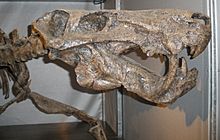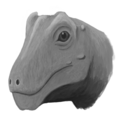Therapsid facts for kids
Quick facts for kids TherapsidaTemporal range: Lower Permian – Lower Cretaceous (non-mammalian)
|
|
|---|---|
 |
|
| Inostrancevia, a therapsid | |
| Scientific classification | |
| Kingdom: | |
| Phylum: | |
| Subphylum: | |
| Superclass: | |
| Class: | |
| Order: |
Therapsida *
Broom 1905
|
| Clades | |
|
|
Therapsids were a group of ancient animals that lived a very long time ago. They are sometimes called "mammal-like reptiles" because they had features of both. These amazing creatures are part of a larger group called synapsids. Modern mammals, like humans, are actually descended from a type of therapsid called cynodonts.
Contents
What Made Therapsids Special?
Therapsids had special jaws that helped them eat different kinds of food. They had incisors at the front for biting, large canine teeth for tearing, and molars at the back for chewing. This made them very good at eating various plants and animals.
Their legs were also different from other ancient reptiles. Instead of sprawling out to the sides, therapsid legs were positioned more directly under their bodies. This allowed them to move more efficiently and probably faster than other animals like Sauropsids and Pelycosaurs.
How Therapsids Evolved
The therapsids faced a huge challenge during the P/Tr extinction event. This was a time when many kinds of animals on Earth died out. Successful groups like the gorgonopsians disappeared completely. The groups that survived were much smaller in number.
After the extinction, two main groups of therapsids became very common. These were the dicynodonts, which were large plant-eaters, and the medium-sized cynodonts. Cynodonts included both meat-eaters and plant-eaters. They spread all over the ancient supercontinent called Pangea during the early to middle Triassic period. Most of them died out before the end of the Upper Triassic, except for some that lived in wet, warm areas.
At least three groups of advanced cynodonts survived. They appeared in the Upper Triassic. One group, called the Tritylodonts, lived until the Lower Cretaceous period. Another important group included animals like Morganucodon. These were very similar to early mammals and are sometimes called "stem-mammals." They are the ancestors of all modern mammals.
Therapsid Family Tree
Here are some of the main groups within the Therapsid family:
- Class Synapsida
- ORDER THERAPSIDA
- Suborder Biarmosuchia
- Suborder Dinocephalia
- Suborder Anomodontia
- Superfamily Venyukoviamorpha
- Infraorder Dicynodonta
- Theriodontia (an unranked group)
- Suborder Gorgonopsia
- Suborder Therocephalia
- Suborder Cynodontia
- Mammaliaformes (an unranked group, very close to mammals)
- Class Mammalia (modern mammals)
Images for kids
-
Illustration of Pristerognathus, a cat-sized therocephalian therapsid
-
Bauria, a therocephalian
See also
 In Spanish: Terápsidos para niños
In Spanish: Terápsidos para niños







